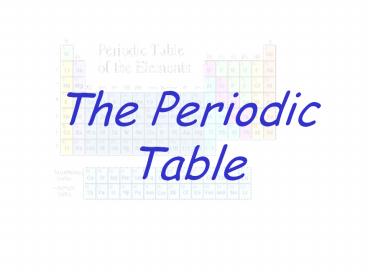The Periodic Table - PowerPoint PPT Presentation
1 / 33
Title:
The Periodic Table
Description:
Modified from original Periodic Table PowerPoint file. Downloaded from The Catalyst, http://www.TheCatalyst.org – PowerPoint PPT presentation
Number of Views:213
Avg rating:3.0/5.0
Title: The Periodic Table
1
The Periodic Table
2
During the nineteenth century, chemists began to
categorize the elements according to similarities
in their physical and chemical properties. The
end result of these studies was our modern
periodic table.
3
Dmitri Mendeleev
In 1869 he published a table of the elements
organized by increasing atomic mass.
1834 - 1907
4
Lothar Meyer
At the same time, he published his own table of
the elements organized by increasing atomic mass.
1830 - 1895
5
Henry Moseley
In 1913, through his work with X-rays, he
determined the actual nuclear charge (atomic
number) of the elements. He rearranged the
elements in order of increasing atomic number.
There is in the atom a fundamental quantity
which increases by regular steps as we pass from
each element to the next. This quantity can only
be the charge on the central positive nucleus.
1887 - 1915
6
Periodic Table Geography
7
Periodic Table
- Columns called Families/Groups
- Family indicates valence (outer shell)
electrons - Elements in same family have similar properties
- Rows called Periods
- Row indicates energy levels in atom
8
The horizontal rows of the periodic table are
called PERIODS.
9
The elements in any group of the periodic table
have similar physical and chemical properties!
The vertical columns of the periodic table are
called GROUPS, or FAMILIES.
10
Metals/Nonmetals/Semiconductors
- Metals excellent conductors of heat
electricity have luster, are ductile/malleable - Nonmetals poor conductors of heat electricity
are dull brittle - Semiconductors(Metalloids) elements that under
certain conditions conduct heat electricity
11
Families of Elements
- Family 1 Alkali Metals
- Family 2 Alkaline Earth Metals
- Families 3 to 12 Transition Metals
- Family 13 Boron Family
- Family 14 Carbon Family
- Family 15 Nitrogen Family
- Family 16 Oxygen Family
- Family 17 Halogens
- Family 18 Noble Gases
- Three general groups metals, nonmetals,
semiconductors(metalloids)
12
Periodic Table
13
(No Transcript)
14
(No Transcript)
15
Periodic Law
When elements are arranged in order of increasing
atomic number, there is a periodic pattern in
their physical and chemical properties.
16
Alkali Metals
17
Alkaline Earth Metals
18
Transition Metals
19
Metals
- Alkali metals (Family 1)
- Very reactive
- Has 1 valence electron
- When ionized has charge of 1
- Alkaline Earth metals (Family 2)
- Reactive
- Has 2 valence electrons
- When ionized has charge of 2
- Transition metals (Families 3 to 12)
- Somewhat reactive
- Valence electron number varies
- Ionized charge varies
20
InnerTransition Metals
These elements are also called the rare-earth
elements.
21
Halogens
22
Noble Gases
23
Nonmetals
- Include H, some elements from families 13 to 16,
all elements from families 17 18. Zig-zag line
divides metals from nonmetals. - Inert gases are unreactive contain 8 valence
electrons - Halogens are very reactive contain 7 valence
electrons gain electrons becoming negatively
charged - Elements in other families gain electrons to
become negatively charged - These elements plentiful on Earth
24
Semiconductors(aka Metalloids)
- Located along the zig-zag line
- Includes
- Boron (B) Silicon (Si), Germanium (Ge), Arsenic
(As), Antimony (Sb), Tellurium (Te), Polonium
(Po) - Notice that Al is not considered a metalloid, it
is considered a metal - Conduct heat electricity under certain
conditions - B is hard added to steel to increase hardness
Sb is bluish-white and shin, Te is silvery-white
electrical conductivity increases with light
exposure, Si important in solar cells
integrated circuits
25
Periodic Table Trends
26
1. Atomic Size - Group trends
H
- As we increase the atomic number (or go down a
group). . . - each atom has another energy level,
- so the atoms get bigger.
Li
Na
K
Rb
27
1. Atomic Size - Period Trends
- Going from left to right across a period, the
size gets smaller. - Electrons are in the same energy level.
- But, there is more nuclear charge.
- Outermost electrons are pulled closer.
Na
Mg
Al
Si
P
S
Cl
Ar
28
2. Trends in Ionization Energy
- Ionization energy is the amount of energy
required to completely remove an electron (from a
gaseous atom). - Removing one electron makes a 1 ion.
- The energy required to remove only the first
electron is called the first ionization energy.
29
Ionization Energy
- The second ionization energy is the energy
required to remove the second electron. - Always greater than first IE.
- The third IE is the energy required to remove a
third electron. - Greater than 1st or 2nd IE.
30
3. Trends in Electronegativity
- Electronegativity is the tendency for an atom to
attract electrons to itself when it is chemically
combined with another element. - They share the electron, but how equally do they
share it? - An element with a big electronegativity means it
pulls the electron towards itself strongly!
31
Electronegativity Group Trend
- The further down a group, the farther the
electron is away from the nucleus, plus the more
electrons an atom has. - Thus, more willing to share.
- Low electronegativity.
32
Electronegativity Period Trend
- Metals are at the left of the table.
- They let their electrons go easily
- Thus, low electronegativity
- At the right end are the nonmetals.
- They want more electrons.
- Try to take them away from others
- High electronegativity.
33
The periodic table is the most important tool in
the chemists toolbox!































